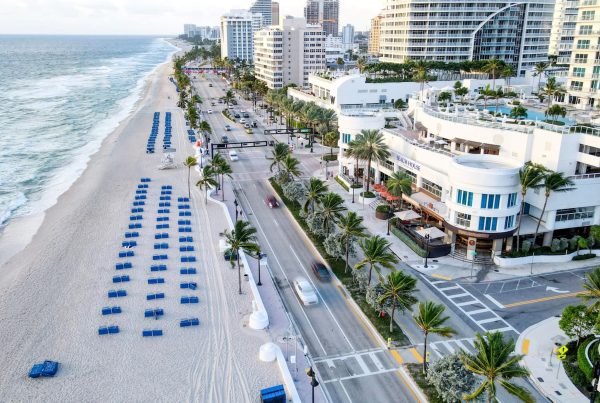The latest dustup between Boca Raton and the Greater Boca Raton Beach and Park District is over the proposed $120,000 fee to district attorney Art Koski for his work negotiating the agency’s purchase of the former Ocean Breeze golf course.
No one at the city, which is underwriting the bonds for the $24 million sale, knew of Koski’s request. Mayor Susan Haynie alerted other council members, city officials and district board members late last week. Haynie told me Sunday that she wanted to make clear that if Koski got the $120,000, it would come from the district. City taxpayers, though, also are district taxpayers.
Koski, who maintains a private legal practice, gets $9,000 per month to be the district’s attorney. He told me this morning, though, that since 1991 his contract has stipulated that he will be paid extra, on an hourly basis, for work related to “litigations or acquisitions.”
According to Koski, he has spent 450 hours on the Ocean Breeze acquisition. At the rate of $400 per hour Koski said he charges the district, the total comes to $180,000.
“I thought that seemed excessive,” Koski said.
After speaking with land-use attorneys, he lowered the fee to $120,000.
Koski regularly defended the $24 million figure when critics said other appraisals valued the roughly 200 acres at less than half that amount. District board chairman Bob Rollins said $120,000 comes out to one-half of 1 percent of the sale prices, which often is the standard rate. Koski, though, denied any link between the fee and the price.
In an email, board member Craig Ehrnst said, “First, I was not informed nor aware of the payment referenced in the letter (from Haynie.) Chairman Rollins was authorized to approve final closing documents with Mr. Koski, and this information was not disclosed to me by neither (sic) Mr. Koski nor Mr. Rollins.”
Ehrnst wants to see “an image and a hard copy of the final closing documents, including closing statement allocating proposed payments.” He later acknowledged that the $120,000 actually went to Koski’s law firm, separate from the other closing payments. Ehrnst acknowledged that he approved two “wire payments” for the closing, “not knowing this was for Art’s legal services.”
He added, “I requested the funds be returned, pending further review and discussion.”
Ehrnst said Koski would get the $120,000 only with board approval.
“I don’t think he was trying to be deceptive, but it should have been discussed.” Changes in the district’s processes “are forthcoming.”
Board member Erin Wright said Koski had mentioned the fee during a “VERY (sic) brief phone call on Friday, but I was unaware that it was being taken out of our accounts. I assumed we would be discussing it at our next regular meeting and we would need to vote on this matter prior to any action taken.”
Board member Steven Engel, though, noted the contract provision for “additional payments for extraordinary items. There is no doubt that the work he has done in putting together the Boca National deal is an extraordinary item.
“Bear in mind too, that we do not reimburse Mr. Koski for travel, secretarial, communications, meals or any other expenses he may incur in connection with his work for the District. All the commissioners were made aware of the fee, including myself. This fee, which amounts to one half of one per cent of the total cost of the property is, in my view, not unreasonable for a transaction of this size.”
Susan Vogelgesang was less certain.
“I am researching the situation,” she said in an email. “Art has worked tirelessly on this acquisition for nearly two years. I’m sure this request will be an agenda item for our next meeting.”
This revelation is not going to affect the sale. The city and the district have approved the agreement for the purchase. The district has heard presentations from golf course architects. What used to be Ocean Breeze will become Boca Raton’s main public golf course.
Yet to outsiders, Koski’s request looks different.
“I see the optics of that,” Rollins said.
So does Koski deserve the money?
“Based on the information presented, it is unlikely,” Ehrnst said in an email. “However, there may be more information that warrants the payment.
“The bigger issue is the lack of transparency and open discussion. I was simply not expecting this as part of the transaction and it was a surprise.”
Wright said, “I am not sure. I want to discuss why there is an extra fee with the closing. This wasn’t ever brought up.”
Koski said his secretary calculates that he has spent 900 hours on Ocean Breeze.
“But that would be an absurd amount to ask,” he said. “I’m willing to eat the cost because (Ocean Breeze) is a great thing for the city and the district. I represent some of the most interesting people in the country. I can bill $500 an hour.
“I’ve been a good guy about this. If (board members) want me to give the (Ocean Breeze) money back, I’ll give the money back. I live in a $5 million house. What the hell difference does it make?”
Koski’s job
In addition to his legal work, Koski is the district’s executive director. He got the job on an interim basis in 2012, following the retirement of Robert Langford. Koski gets $7,500 per month for that work. That’s almost $200,000 per year. Yet Koski said, “I lose money $300,000 on that ‘work,’” based on the time he puts in. He also served as project manager until the district hired former city building official Michael Fichera.
Though board members finally removed the “interim” from Koski’s title, they appeared ready in 2016 to promote Assistant Director Briann Harms and keep Koski only as the attorney. Harms, though, said the transition might work better after the elections, so the new board could decide.
Almost a year and a half since that election, Koski is still the director. “I don’t want the job,” Koski said, noting that he had a stroke on Jan. 31. “But every time I bring it up, they tell me, ‘You’re not leaving.’ “
The district has just two full-time employees. Koski, rejected the idea, but it seems more and more that he essentially is the district.
I-95 Interchange
How long has Boca Raton been waiting for the Interstate 95 interchange at Spanish River Boulevard?
Most elected officials credit former U.S. Rep. E. Clay Shaw with securing the roughly $70 million. Shaw died in 2013 and had been out of office since 2006.
Current officials, correctly, will invoke Shaw’s name Wednesday during the ribbon-cutting ceremony for the interchange. Some ramps have been open since the fall, but this week all ramps will open and residents will start finding out if the money was worth it.
Boca Raton began pressing for the interchange when Florida Atlantic University wanted to build a football stadium on campus. Northbound traffic heading to FAU on I-95 already backed up at Glades Road, and city officials feared that the chokepoint at Glades and Airport Road would get even worse if 40,000 people were converging for a game. FAU had made the chokepoint worse by converting what had been proposed for married student housing into what is now University Commons—home to Whole Foods, other retailers and several restaurants.
As it turned out, FAU cut the stadium size to 30,000. And early on, it didn’t seem to matter. FAU’s team didn’t win much. The stadium drew small crowds.
Now, however, Lane Kiffin has made the Owls big winners. FAU President John Kelly, who came from football power Clemson, considers the team a recruiting tool. He also wants a bigger FAU. The Research Park at FAU is attracting more aspiring entrepreneurs.
Key to making the interchange work as planned is getting all that northbound FAU traffic—Broward County is the largest source of commuter students—to drive a bit farther north, which can seem counterintuitive. Mayor Susan Haynie said FAU plans “an education piece.”
Spanish River Boulevard currently rates E on the state scale— with F, a failing road, being the worst. Haynie hopes that the interchange will raise that to a D, but Boca Raton won’t know the effects until the Florida Department of Transportation completes its seasonal traffic count. That is happening now.
Haynie noted that I-95 soon will gain an auxiliary lane in each direction to Congress Avenue as part of the 10-laning of the highway. She believes that the additions will take traffic off Military Trail, which drivers have been using to avoid the interstate.
Eventually, two lanes in either direction will be toll lanes, though the state prefers to call them “express lanes.” As part of that work, an overpass on Glades should help to reduce backups.
Other improvements will come with construction of the interchange and its 13 overpasses. Spanish River Boulevard will be widened west of FAU Boulevard and traffic signals will be updated. Cyclists will be able to enjoy a connected El Rio Trail that allows them to avoid traffic at Yamato Road.
The opening of the interstate is a big deal. Let’s hope that the benefit is just as big.
Yamato Villas
Two items of note are on tonight’s Boca Raton City Council agenda.
Yamato Villas is back. The developer proposed to build 16 townhouses and three single-family homes on roughly two acres along Yamato Road between I-95 and Dixie Highway. One of the five items before the council is a land-use change, which requires four votes, from single-family to multi-family.
Though some neighbors to the south have spoken against the change, city planners support the project because it would mean fewer driveways onto Yamato Road and thus would increase safety. The city zoned the land single-family decades ago, when Yamato was quieter.
During previous discussion of Yamato Villas, Councilwoman Andrea O’Rourke complained that the project would add students at crowded schools. O’Rourke has proclaimed that the council should not add “one more student” until there is more capacity. As noted many times, however, the council cannot reject a project because of its impact on schools. It would be good if Florida had such a law—known as school concurrency—but the Legislature and Palm Beach County have rejected that requirement.
GL Homes sale
We began this post with an item related to golf. Here’s another.
Also before the city council is a change to the contract with GL Homes for purchase of Boca Raton’s western course. During the 90-day inspection period since the council approved the $65 million contract, GL and the city have discovered roughly four acres that the city had thought belonged to the Lake Worth Drainage District for use as a canal. In fact, the city owns the land.
The city, though, has no use for them. So City Manager Leif Ahnell proposes deeding them to GL, to avoid creation of a pocket parcel. GL probably can’t develop the property, but if the land allows GL to build more than its projected 566 residential units, the company will pay for those rights.
Delray school violence resolution
Mayor Glickstein, who leaves office next month, told me Monday that he’s working on a resolution regarding school violence. Glickstein spoke at the rally in Delray following the Marjory Stoneman Douglas shooting.
The Boca Raton City Council will discuss a similar resolution tonight. It includes references to school safety and to possible regulation of firearms.
Hager’s vote
State Rep. Bill Hager, who represents Boca Raton and some of Delray Beach, voted with his Republican colleagues last week against even debating legislation to ban assault weapons in Florida.







